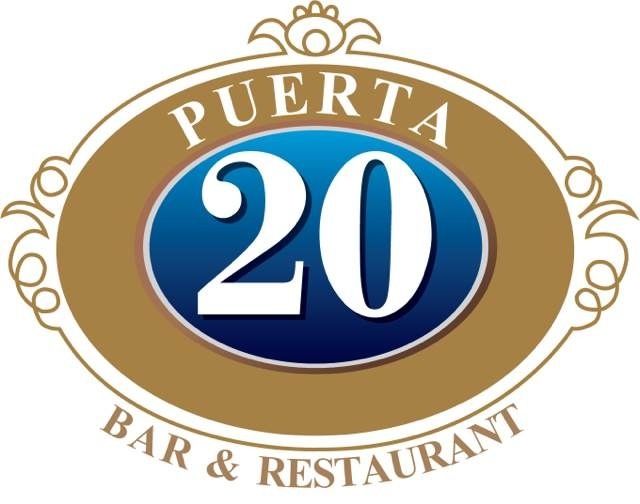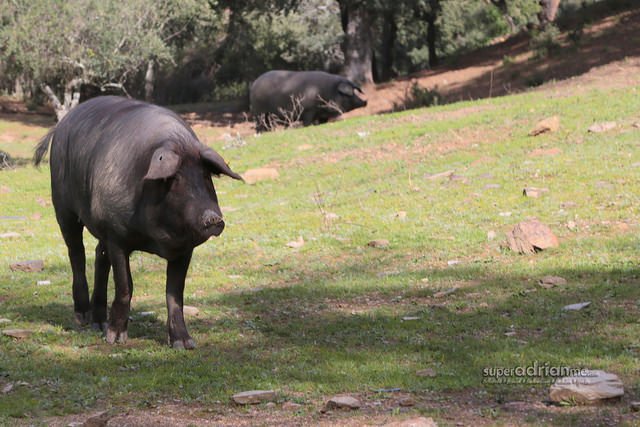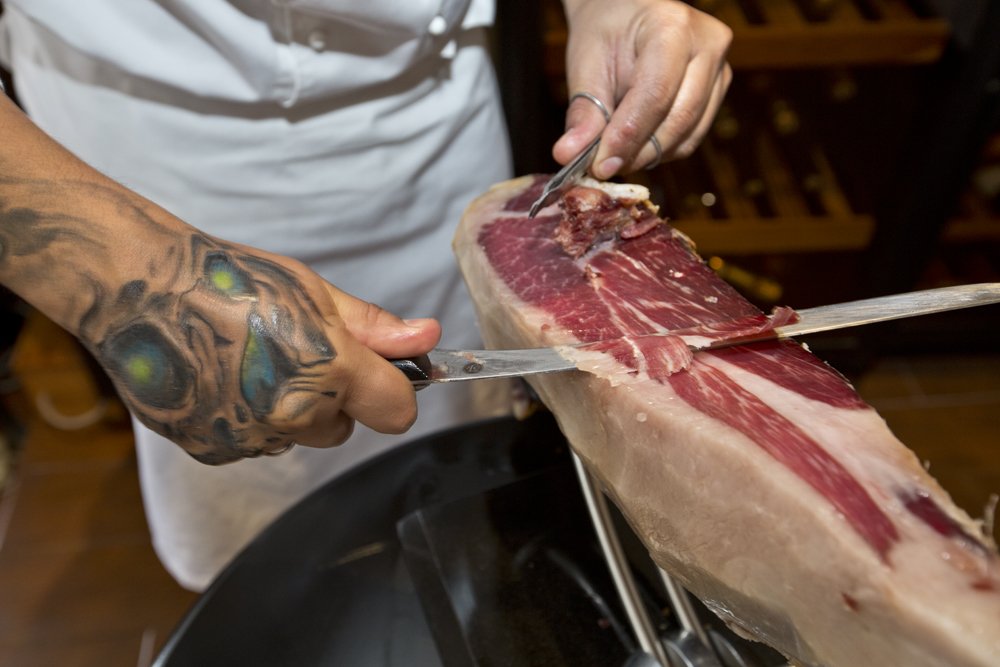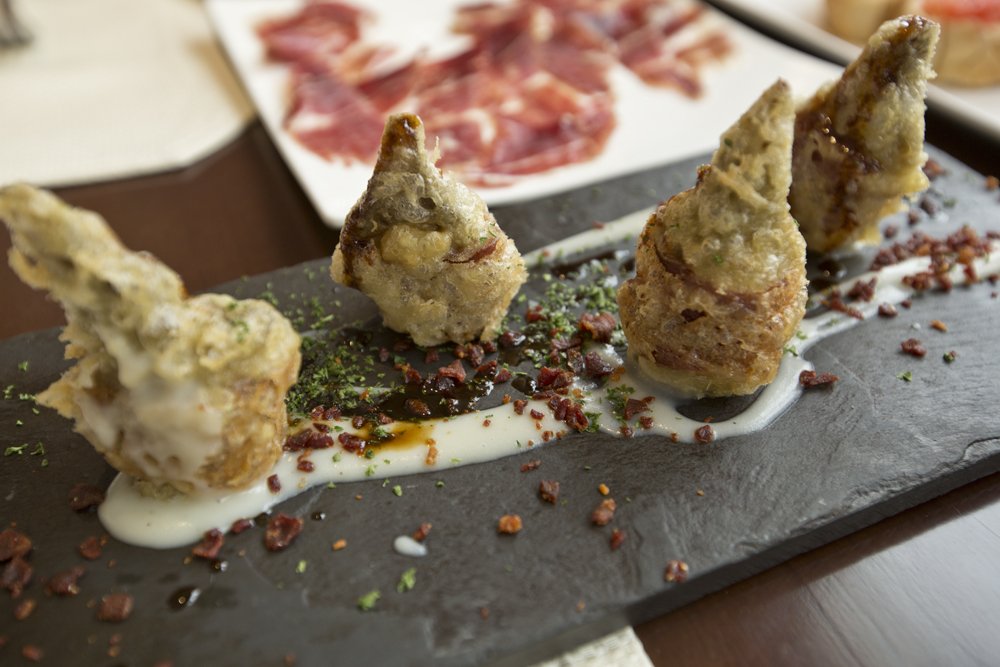Jamon! Jamon! Ten Mouthwatering Facts About Puerta 20's Specialty Ham
 This post is sponsored by Puerta 20, a world-class Spanish restaurant located in the Worker’s Stadium complex.
This post is sponsored by Puerta 20, a world-class Spanish restaurant located in the Worker’s Stadium complex.
Chef Maiker Valdivia’s sharpened knife glints as he draws its edge along the jamon leg. But that pink, fatty, high quality meat glistens even more than the blade that’s slicing it, and each piece that’s removed is so thin that it’s practically transparent.
“I really enjoy cutting jamon,” explains the master chef as he prepares the famed Spanish delicacy in the brightly lit dining room of Puerta 20, a contemporary Spanish restaurant located in the Workers Stadium complex. “I move slowly and the jamon seems to come off by itself — very thin, very thin. It’s a quiet time for me. I look at the knife, I look at the meat, and I can think about the quality of the meat, how good it is and how good it will taste.”
We recently had the pleasure of sampling some of this delicious delicacy over at the restaurant, and got the lowdown on what is arguably Spain’s most international culinary export from the man himself. Here are ten of the most interesting tidbits:

1. It’s crucial to pick a quality pig
Like veal and lamb, jamon is made from the finest, tenderized cuts of young livestock. But the best cuts come one particular breed of Lampiño pigs. Valdivia says these black Ibérico piglets are held in such high regard that the Spanish government placed it under the same Denominación de Origen classification system used for its fine wines and cheeses. “Some farms use Lampino and another kind of pig for breeding, meaning the babies won’t be pure. So the government makes labels and levels that customers can see, so that they know how pure the jamon is.”
2. People truly go nutty for the flavor
In addition to ensuring that their livestock are thoroughbred, Valdivia says jamon farmers also take great care in choosing what they feed to the piglets. The distinctively sweet nutty flavor of the 5J Ibérico jamon served at Puerta 20 can be attributed to the fresh nuts that these pigs are fed for four months, from November to January, before their slaughter.
3. 5J is the only way
Speaking of the source of Puerta 20’s jamon, the restaurant exclusively uses 5J Sánchez Romero Carvajal for its cured ham delicacy. 5J is not only known as the biggest producer of jamon in Spain, the hammarket.com, it’s also “quite possibly the world’s tastiest ham because they use the most traditional methods to make it,” according to Chef Valdivia.
4. Quality jamon is aged finer than wine
Valdivia says restaurant-quality jamon cannot be hastily prepared. It is a slow, subtle process, and the amount of time taken should vary according to the chef’s needs and the customer’s desires. “If jamon has less time to dry, the meat is redder. It’s like wine, which needs to stay in a bottle for a few years before you can drink it. It’s also like cheese — if you cut it at different times, it has different flavors. Some jamon will be drier, others will be more fatty. Some will be more salty, others will be sweeter. It all depends on how long you cure it.”

5. Cutting calmly is the key
Even the most painstakingly, patiently cured jamon can be ruined in one fell swoop – or more aptly, one fell slice. Of all the intricate details involved in preparing jamon, Chef Valdivia says the slicing of the meat is most important. “I had to cut ten legs before I had a handle on the technique. After the tenth leg, I finally understood,” he explains. The key to the technique is surprisingly simple: put less pressure on yourself, and put even less pressure on the blade.
“The first time I tried, I was a bit nervous and cut too much, because the whole time I was thinking: “Maybe I’m no good,” Chef Valdvia adds. “But if you have a good knife, and you go slowly, slicing and not putting too much pressure, then your knife will barely need to cut and slice. The jamon, if it’s high enough quality, will practically come off of the bone itself.”
6. Slicing jamon can be a double-edged sword
While Valdivia insists that an experienced and steady hand is the key to slicing the finest cuts of jamon, he admits that even the most inept newbie can likely still wield that blade better than his most popular, and least personal, counterpart: “At this restaurant we always cut the meat by hand … with no machines … mechanized slicing of jamon is not suitable for fine dining.”
There is one thing, however, that chefs who slice by hand must never do: waiting too long to serve the jamon. “Some restaurants cut their jamon with a machine, and some cut it by hand and then pack it in a bag to be served later. You can find this kind of jamon in the supermarket. The pressure of the bag that the jamon is packed in changes the flavor. It will lose fat and become like paper.”
7. When it comes to jamon, fat is an asset
“Cut the fat” may be a common expression used to halt nonsense, but it doesn’t apply for jamon. In fact, the fat is one of the best parts of these spindly slices of cured meat. Valdivia says that many patrons focus on the pink or redness of the meat, but he points out that the white streaks of fat, and the white spots of crystallized sugar not only add other colors but also a spectrum of flavors to every bite of these 5J slices.
8. “Don’t forget dem bones”
Speaking of the fat, Valdivia says that the jamon leg’s bone produces natural fats. This is what makes high quality jamon glisten. Without the bone it will be drier, unlike good quality slices where the fat and grease can be seen.

9. A little jamon can make a dish go a long way
Jamon is a popular dish on its own, but Valdivia also uses it as an ingredient to augment the flavors of other dishes like his delectable artichoke tapas and, more impressively, the egg soup served at Puerta 20. This second implementation of jamon is more creative because it doesn’t use the meat, but instead the bone of the Lampino’s leg, creating a jamon flavored broth that the egg can rest in. The soup is served on a plate that is piping hot — not because of its contents, but because it doubles as a pot, being placed encasing the ingredients over the fire, so that when it is removed the egg is not broken. This just goes to show that all things jamon are nuanced, even when they’re used as a soupy secondary ingredient.
10. Jamon has played important roles in history
These savory meat slices are renowned as a delicacy today, but jamon also has a fabled past: According to one source jamon was a favorite treat that Columbus indulged himself with on the Santa María’s ocean spanning odyssey to the New World. Legend has it, that the cured ham was also frequently served to patrons by wily barkeeps who used its saltiness to dry people’s throats, ensuring that they would all eat, drink and be merry.
Photos: Uni You







